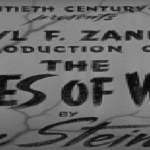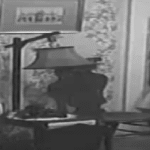Released at the dawn of the sound era, Abraham Lincoln (1930) marked a major transition not just in American cinema but in the storied career of one of its earliest pioneers. D.W. Griffith. Known for groundbreaking but controversial silent epics like The Birth of a Nation (1915) and Intolerance (1916), Griffith attempted to reassert his influence in the talkie age with this biographical film chronicling the life of the 16th president of the United States.
While Abraham Lincoln may lack the narrative dynamism or technical audacity of Griffith’s silent films, it is nevertheless a sincere and occasionally moving portrait of a figure who had, by 1930, already achieved mythic status in American consciousness. Starring Walter Huston in a commanding early talkie performance, the film attempts to compress Lincoln’s complex life into a single, 90 minute feature, spanning from his humble beginnings in Kentucky to his tragic assassination at Ford’s Theatre.
By 1930, D.W. Griffith was facing a rapidly changing cinematic landscape. The silent era was ending, and sound films had taken over Hollywood. Griffith, whose innovations in silent film grammar had once made him a titan of the medium, was struggling to find his voice, literally and figuratively, in this new era of synchronised sound.
Abraham Lincoln was his first full-length talkie and, ultimately, his final major directorial effort. With this film, Griffith sought not only to adapt to the changing technologies of cinema but also to rehabilitate his public image. His legacy had been deeply tarnished by The Birth of a Nation, a technically brilliant but openly racist film that sparked widespread controversy. With Abraham Lincoln, Griffith turned his focus to a unifying American figure, one synonymous with justice, equality, and national healing.
One of the film’s great strengths lies in the performance of Walter Huston as Abraham Lincoln. Huston, who would go on to enjoy a prolific career in both film and theater, brings a mix of solemn dignity and approachable warmth to the role. He captures Lincoln’s folksy mannerisms, his dry wit, and his deep internal struggles with surprising nuance for an early sound performance.
In a time when many actors were still adapting from the exaggerated expressions of silent film to the subtleties required by sound, Huston’s performance is remarkably natural. His Lincoln is neither a saint nor a caricature, but a man shaped by hardship and responsibility, a frontier lawyer turned reluctant leader whose personal sorrows run parallel to the nation’s own growing pains.
Abraham Lincoln follows a largely linear narrative structure, presenting key moments in Lincoln’s life in chronological order. The film begins with a brief depiction of his early years in Kentucky and Indiana, including his relationship with Ann Rutledge, whose death casts a long emotional shadow. It then moves through his courtship of Mary Todd, his legal and political rise, and his fateful presidency during the Civil War.
The film attempts to balance Lincoln’s personal life with his public achievements, though some transitions feel abrupt due to the time constraints of the feature format. Entire decades are passed over in minutes, and the Civil War, arguably the defining event of Lincoln’s life and presidency is addressed through a series of vignettes rather than a detailed examination.
Nevertheless, the film includes several poignant moments, such as Lincoln’s emotional turmoil over the death of his son Willie, his inner conflict about the human cost of war, and his moral wrestling with the question of slavery. The final scenes, which depict his assassination and the nation’s mourning, are handled with somber reverence.
As an early talkie, Abraham Lincoln exhibits some of the technical challenges common to the era. The sound quality is uneven at times, and the film is often static in its camerawork, clearly constrained by the limited mobility of early sound equipment. Dialogue scenes sometimes feel stagey, and background noise is minimal or absent, giving parts of the film a slightly artificial tone.
Still, there are glimmers of Griffith’s old brilliance in the composition of certain shots, particularly in the use of lighting and crosscutting to evoke emotion. In one particularly effective scene, the camera lingers on Lincoln’s anguished face as he listens to casualty reports from the battlefield, intercut with shots of the wounded and dying, a moment that recalls Griffith’s silent-era montage techniques.
The script, co-written by Stephen Vincent Benét (author of the epic poem John Brown’s Body), offers eloquent, if occasionally flowery, dialogue. Lincoln’s speeches are delivered with an orator’s cadence, in keeping with the theatrical style of early talkies, and are meant to inspire rather than merely inform.
Abraham Lincoln is not without its flaws. It compresses a vast and complex life into a brisk runtime, and in doing so, it simplifies many of the historical and political nuances. The film skirts over Lincoln’s evolving views on slavery and his contentious relationships with his generals and cabinet. Mary Todd Lincoln, played by Una Merkel, is depicted in a fairly one dimensional manner, mostly as a source of domestic strife.
Additionally, the film does little to confront the racial dimensions of Lincoln’s presidency in any meaningful way. African American characters are almost entirely absent, and the Emancipation Proclamation is referenced more as a historical milestone than a moral turning point.
Yet despite these shortcomings, Abraham Lincoln reflects a sincere effort to honor a man whose legacy had become central to American identity. Griffith’s reverent tone and Huston’s sensitive portrayal help elevate the film beyond mere historical reenactment. There is a genuine sense of admiration and solemnity that runs through the film, and for many viewers of the time, still reeling from World War I and entering the Great Depression. Lincoln’s story offered a reminder of endurance, principle, and unity.
Though not a box office hit, Abraham Lincoln marked a symbolic farewell to Griffith’s long and complicated career. He would never direct another major film. By 1931, he was effectively sidelined in Hollywood, as newer, younger directors, more attuned to the rhythm and demands of sound cinema, rose to prominence.
Today, Abraham Lincoln is viewed as a transitional work. It bridges the silent and sound eras, and in many ways, it reflects the growing pains of both the medium and its maker. While it doesn’t reach the artistic heights of Griffith’s earlier films, it serves as a respectful, heartfelt tribute to a national figure whose life still resonates nearly two centuries later.
In its moments of stillness, sorrow, and reflection, Abraham Lincoln reminds us that the measure of a man and a nation, is not in grand gestures alone, but in quiet courage, moral clarity, and the willingness to do what is right, even when it’s hard. That message, like Lincoln himself, never goes out of style.







